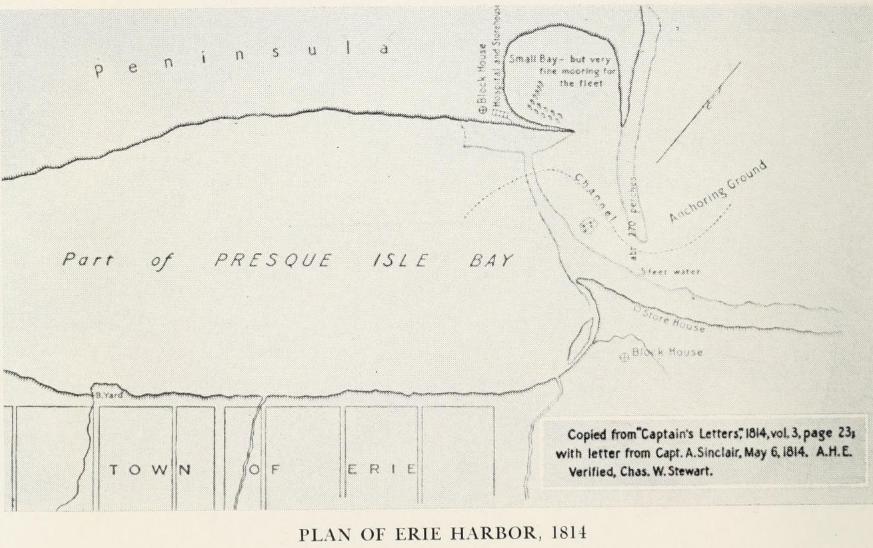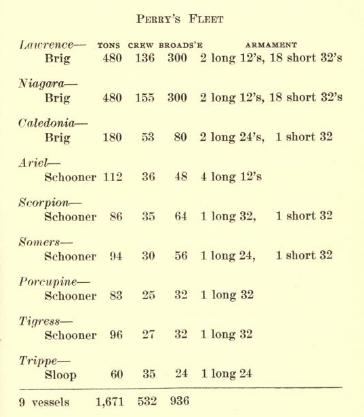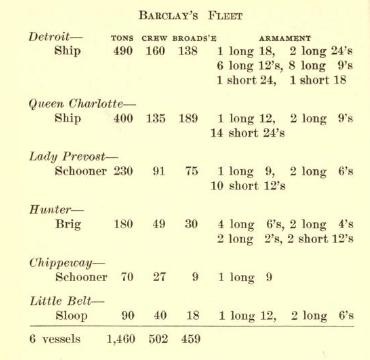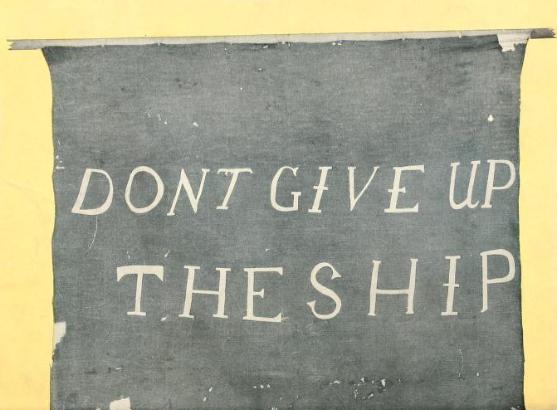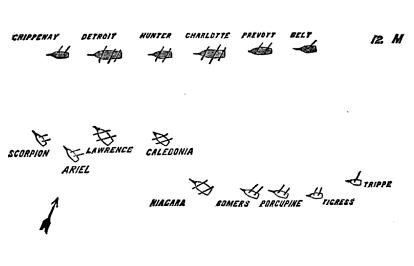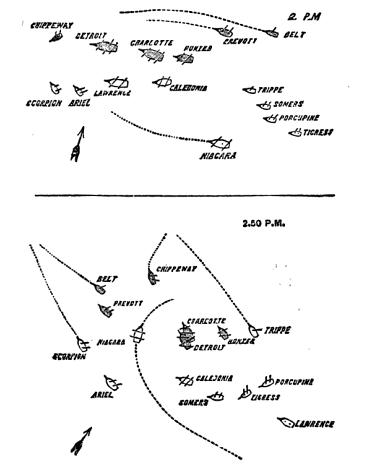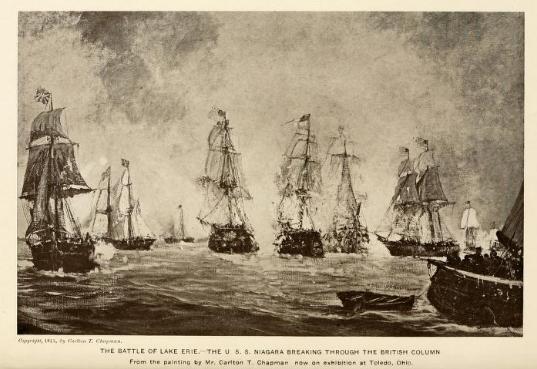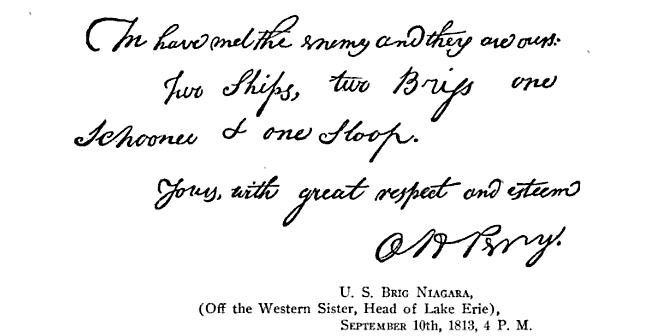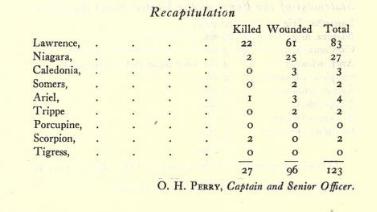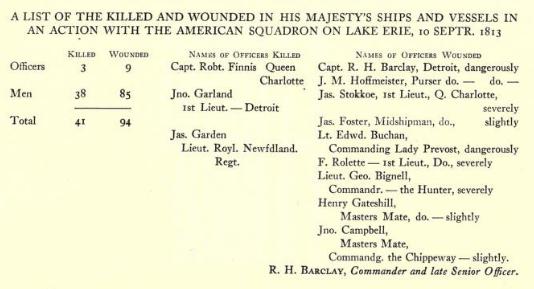This page is designed to allow our readers to explore the Battle of Lake Erie at their own pace. The editors McConnell/Schilling have gathered snippets from old books and newspaper articles that tell the story of the Battle of Lake Erie.
Each section is directly linked to a source document which allows the reader to explore any particular topic in greater detail. Simply click on [ source: ] to bring up the freely available document. Many thanks to Archive.org and Google books for making documents such as these freely available.
The vast majority of these words are those of the authors. Minimal alterations have been made to bring greater clarity to the stories. A full listing of references is included at the end.
The Battle of Lake Erie was fought in the western part of the primary theater of war, on September 10, 1813, midway in time between the commencement of the conflict in June, 1812, and its close in February, 1815. This battle was the turning point of the war in the west. Previous to it, the American offensive campaign in that quarter had been uniformly unsuccessful. [ source: 1918 Battle of Lake Erie C. Paullin page 19 ]
The situation on Lake Erie at the close of the campaign of 1812 was far from favorable to the American cause. The British squadron under Captain Finnis enjoyed undisputed control of the Lake and its shores.
Before the opening of the 1813 hostilities on the lake the American authorities fortunately awoke to the fact that any further movement for the recapture of Detroit and the invasion of Canada would have to depend upon the naval control of Lake Erie, and that that in turn depended in a large measure upon their own superiority on Lake Ontario. [ source: 1913 Battle of Lake Erie – R. Neeser page 8-9 ]
Erie Pa. resident Daniel Dobbins who had been an eyewitness to the surrender of Detroit had intimate knowledge of the lake region and was dispatched to Washington. Because of his knowledge of the region, Dobbins had been invited to the conferences in which the program of ship building was resolved. His choice of the site for the construction of the vessels was accepted and, in addition, Dobbins was commissioned a sailing master in the United States Navy with authority to begin the execution of the plans. [ source: 1950 Building Fleet M. Rosenberg page 21 ]
On September 11, 1812, Dobbins received a note from the Secretary of the Navy, Paul Hamilton, requesting his presence at a conference. Dobbins was by far the most completely informed person in Washington concerning matters pertaining to Lake Erie. At the conference, plans for a lake force were formulated. Dobbins named Erie as the best and only comparatively safe place for the fleet to be constructed. The Navy Department accepted this advice. Mr. Hamilton then gave Dobbins the following instructions:
You will proceed without delay to Presque Isle, on the Lake Erie, and there contract for, on the best terms in your power, all the requisite timbers and other materials for building four gunboats agreeably to the dimensions which you will receive from Commodore Tingey; and if in your power you will contract for the building of those boats, but such contracts must be submitted to Commodore Chauncey, or the officer that may be appointed by him to command the naval forces on the Lake.
To enable you to comply with the engagements you may make, you can draw on this Department for any sum not exceeding Two Thousand Dollars. Copies of all contracts you may make you will transmit to this Department for Paul Hamilton – C. W. Goldsborough [ source: 1950 Building Fleet M. Rosenberg page9 ]
The invasion of Canada was a failure and Detroit, Mackinac, and Fort Dearborn had been surrendered for various reasons. Among the more important were: an unsettled and undeveloped land area without industrial facilities; no roads, or roads that were muddy paths; and water supply routes which went to the enemy uncontested. It added up to an army attempting to advance with long communication lines and transportation routes so undeveloped and so uncertain that their value was well-nigh worthless. These conditions also prevailed in the area where the fleet of two brigs and four gunboats was to be built. [ source: 1950 Building Fleet M. Rosenberg page11 ]
![]()
From the city of Erie, roads branched out toward Buffalo, Pittsburgh, Cleveland and even to the mountainous sections of central Pennsylvania. To Buffalo, two roads had been marked out, one in 1805, the other in the following year. Both were in use, but only when absolutely necessary, for neither was more than a path through the forest or along the lake shore. The time spent traveling and the hardships endured were incredible.
Dobbins in April, 1813, attempted to bring three pieces of ordnance from Buffalo. “I started from Buffalo with three pieces but got through with only one. After a most perilous expedition owing to the bad state of the roads, freshets in the streams, and washing away of bridges, breaking through the ice etc.,”
[ source: 1950 Building Fleet M. Rosenberg page16 ]
Overland hauling was unsatisfactory for a very simple reason. Although western Pennsylvania was covered by a network of roads by 1812, it cannot be said that they provided satisfactory avenues of travel and transportation. In general the roads were not constructed; they were merely ‘opened’—that is, the trees were cut down and stumps were grubbed out. Sometimes a little digging was done on side hills and in passes, swampy places were filled with logs laid crosswise with a little dirt on top of them, and crude wooden bridges were constructed over some of the smaller streams. Little effort appears to have been made to avoid steep inclines, and culverts were practically unknown. Road maintenance consisted merely of the removal of fallen trees and the dumping of dirt into mudholes and washouts. . . .A trip over almost any of the roads with a wagon or a carriage was a difficult and hazardous experience, especially in the winter or spring. [ source: 1950 Building Fleet M. Rosenberg page17 ]
At the time of Perry’s arrival to Presque Isle, March 27, the place was entirely defenseless, and without any organization for defense, although the keels of the two brigs were laid, and the three gunboats well advanced in construction. By a visit to Pittsburgh he obtained from an army ordnance officer four small guns, with some muskets; and upon his application the local commander of Pennsylvania militia stationed at Presque Isle five hundred men, who remained till the vessels crossed the bar. Under this slender protection went on the arduous work of building and equipping a squadron in what was substantially a wilderness, to which most of the mechanics and material had to be brought half a thousand miles from the seaboard, under the difficulties of transport in those days. [ source: 1903 Sea Power A. Mahan page 68 ]
He found that the two brigs, Lawrence and Niagara, were already in course of construction, also three other vessels of lesser tonnage and lighter build. So hurried were the shipwrights that many a tree which waved its branches in the sunrise breeze found itself chopped, hewn, squared, and tree-nailed into the ship’s hull before the evening sun had set over the lake. Despite this rapid construction, all the vessels appear to have been well built, and certainly accomplished the object for which they were designed. [ source: 1901 Perry’s Victory G. Eaton page 5 ]
[ image source: 1950 Building Fleet M. Rosenberg page61 ]
July 20 Barclay appeared off Erie pennisula, where Perry’s fleet was still in the harbor, waiting for men. How imminent the exposure of the American flotilla at that moment, and how great the British opportunity, appears from the recently published memoirs of a prominent resident. ” An English fleet of five vessels of war was at that time cruising off the harbor, in full view. That fleet might at any time have sent in its boats during a dark night, and the destruction of the whole American fleet was almost inevitable ; for Perry’s force was totally inadequate to its defense, and the regiment of Pennsylvania militia, stationed at Erie expressly for the defense of the fleet, refused to keep guard at night on board.
[ source: 1903 Sea Power A. Mahan page 70 ]
Presque Isle or as the place is now called Erie was a good and spacious harbour but it had a bar on which there was less than seven feet of water. This bar which had hitherto answered the purposes of a fortification now offered a serious obstruction to getting the brigs on the lake It lay about half a mile outside and offered great advantages to the enemy did he choose to profit by them for attacking the Americans while employed in passing it. So sensible was Captain Perry of this disadvantage that he adopted the utmost secrecy in order to conceal his intentions for it was known that the enemy had spies closely watching his movements.
Captain Barclay had lately superseded Captain Finnis in the command of the English force and for near a week he had been blockading the American vessels evidently with an intention to prevent their getting out it being known that this bar could be crossed only in smooth water. On Friday the 2nd of August he suddenly disappeared in the northern board.
The next day but one was Sunday and the officers were ashore seeking the customary relaxation. Without any appearances of unusual preparation Captain Perry privately gave the order to repair on board the respective vessels and to drop down to the bar.
[ source: 1845 Army and Navy J. Neff page 548 ]
To carry them out over the bar, in the face of this enemy, superior in force, had they all been furnished with guns, and, as it must be, entirely unarmed, was a labor, which tasked the Yankee invention, no less than the valor, of the young Commodore and his associates. They were loaded on the backs of camels, and carried out over the bar into deep water.
These camels were of simple mechanism, and American manufacture. They were long, broad, deep boxes, made of planks, like scows, and perfectly water tight ; with holes to fill, and sink, and pumps to exhaust them of water, and raise them so as to float with their upper edge high above the surface. These, placed on each side, and connected by strong beams, on which the vessels being placed when they were sunk; thus raised the vessels up above the bar, when the camels were pumped out, and rose again by their own buoyancy.
[ source: 1839 Elliot’s Conduct T. Burges page 21 ]
Perry’s officers were mostly young, without knowledge of the lake navigation and the difficulties incident thereto, though at home upon the deck of a man-of-war at sea. The average age of Perry’s commissioned officers was twenty-three and average age of warrant officers was less than twenty years.
[ source: 1913 Battle of Lake Erie W. Dobbins page 37 ]
The first trip of the squadron, August 5th, consisting of eight vessels, half officered and manned, was across the lake to Long Point, in pursuit of the British squadron of five vessels, the largest ship Detroit being then at Malden, not ready for sailing. Returning to Erie the following day there was found a reinforcement of men and officers just arrived from Lake Ontario. In this brief excursion across the lake, so short was the supply of experienced officers, that young Turner, still a minor, commanded the Niagara of 20 guns. But this party arriving from Lake Ontario gave the command of the Niagara to Capt. Elliott, and young Turner was ordered to the third ship, the Caladonia. When the line of battle was formed, the Caledonia ranked as fourth vessel in the line, the two schooners Ariel and Scorpion, commanded by Packet and Champlin, being ahead, followed by the flag ship Lawrence, then the Caledonia, Lieut. Turner, and the Niagara and four smaller vessels. [ source: 1862 Brief Sketches U. Parsons page 8 ]
On the twenty fifth of August, Perry got underway with his squadron from Put-in-Bay, and stood across the head of the lake for Malden, to see if he could not draw the enemy out. He discovered them at anchor inside of Bar Point, within range, he concluded it to be not practicable to make an attack at this time. He could see from the offing that they were not yet reinforced by their new ship.
At this juncture much sickness was in the squadron, consisting of bilious fever, dysentery, and chills; those mostly affected were from the seaboard. The change from salt to fresh water, coupled with impure salt provisions and few vegetables, was fruitful of disease, and Parry was take down himself, and a number of his officers, including Barton and Parsons.
[ source: 1913 Battle of Lake Erie W. Dobbins page 60 ]
On the 31st of August the squadron received a welcome reinforcement from General Harrison’s army, in the way of fifty volunteers, including several officers and one doctor W. T. Taliaffero. They were mostly from Kentucky, and many of them had been boatmen on the Western rivers, which as “watermen,” gave them a slight knowledge of the duties they were required to perform. They were immediately distributed throughout the squadron to serve as “marines,” in place of the” marine guard” which had been promised from Lake Ontario. This brought the muster-roll up to about 490, all told. Great attention was paid to drilling the men in their various duties, and in making every preparation for battle, as it was daily anticipated. Perry became convalescent after a weeks confinement, and was able to take the deck again, and got the squadron underway for a second visit to Malden. On his arrival at that place he found they had their new ship “Detroit” fully equipped and at anchor with the rest of the squadron.
[ source: 1913 Battle of Lake Erie W. Dobbins page 61 ]
When the fleet sailed from Erie to meet the enemy, Thomas Breeze was appointed commodore’s aid in battle, the other aid being Perry’s brother Alexander, a lad of thirteen years. The duty of aids is,” to run with the commander’s orders to all parts of the ship, for amid the din and uproar of battle, the crash of timbers and shrieks of the wounded, orders are hardly audible at the distance of ten feet. Fleetness of foot and self-possession were the requisites for this service, and which is best performed by youths in their teens. Towards the close of the battle, the marines are required to lay aside their muskets and work at the cannon, in place of sailors who are knocked down and disabled at the guns. But the marines were here all used up and still more aid was needed, and here young Breeze, with other officers, seized hold of the ropes and exerted every nerve as common sailors, in working: the last guns.
[ source: 1862 Brief Sketches U. Parsons page 5 ]
On the first of September, after a week’s confinement to his berth Commander Perry found himself sufficiently well to again take the deck; and he lost no time in getting his fleet once more in motion. He stood off toward Malden, and, as the weather was settled and the wind from the northeast, which was favorable for standing in and out of the Detroit River, he ran very close in. With his colors set and decks cleared for action he continued off the harbor the rest of the day, defiantly bearding the British to come out and engage him in an open and nearly equal contest. They had, he found, equipped their new ship, which they proudly named Detroit as a memorial of their conquest; and had armed her with guns of every caliber taken from the ramparts of Malden. “A more curiously composite battery probably never was mounted,” says Mahan, “but of a total of nineteen guns, seventeen were long guns of great range; and all her pieces together fired two hundred and thirty pounds of metal.”
[ source: Oliver H Perry James Mills page 110 ]
September 3rd. At this time three men, favorable to the American cause, made their escape from Malden and communicated to Perry much valuable information; that the forces at Malden were very short of provisions and that a council of military and naval commanders was held and determined their squadron should sail and give battle to ours on the lake, or make an attempt to open communication with Long Point, their depo of supplies. These men also gave information in regard to their squadron and armament. Their flagship, “Detroit” Commodor Barlcay was armed with nineteen long guns; the “Queen Charlotte, ” Captain Finnis, seventeen carronades; “Lady Provost,” Lieutenant Commander Buchan. Thirteen long guns; brig “Hunter,” Lieutenant Bignall, ten guns (mixed armament;) “Little Belt,” three guns; schooner “Chippewa,” Master Campbel, one heavy gun; with 32 officers and 490 men, including troops servicing as marines and volunteers.
[ source: 1913 Battle of Lake Erie W. Dobbins page 66 ]
The commander of this small but well-armed British squadron was Robert Heriot Barclay, a veteran officer with the rank of captain, who had served with distinction in many of those naval engagements which had rendered the name and flag of England so feared on the ocean. He had been with Nelson, as before stated, and been desperately wounded in the ever memorable sea fight at Trafalgar. More recently, in an action with the French, as first lieutenant of a frigate, he had lost an arm. His first officer next in rank was Captain Finnis, in command of the Queen Charlotte, who was a brave and skillful seaman. [ source: 1913 Oliver H Perry J. Mills page 113 ]
On the fifth of September, while anchored in Sandusky Bay, three refugees arrived from Malden who told him that the British had determined that their squadron should put forth into the lake in the course of a few days to engage him. He also received more accurate information than he had yet obtained as to the strength of the enemy’s fleet. Besides having minor details of the equipment of their new ship, the Detroit, he learned that this vessel and the Queen Charlotte each had one of their long guns mounted on a pivot, so that it could be trained in a wide arc of a circle.
[ source: 1913 Oliver H Perry J. Mills page 113 ]
The effective strength of the American fleet was greatly reduced at this time by sickness and general debility; and there were no less than one hundred and sixteen cases on board the different vessels, seventy-eight of which were bilious fever. From this cause the actual number of men able to be on deck and fit for duty was only four hundred and sixteen, which rendered the physical force greatly in favor of the British. The knowledge of this fact, however, did not check Commander Perry’s repeatedly expressed desire to meet them, as he had a just sense of his own resources, and a proper confidence in himself. [ source: 1913 Oliver H Perry J. Mills page 116 ]
The total armament of the American fleet was fifty four guns, or nine less than the British fleet, and a large proportion were short carronades which, though of larger bore, were effective only at comparatively short range. There were no less than thirty-nine 32-pounder carronades, and only fifteen long guns, of which three were 32’s, four were 24’s, and eight were 12’s. This was an armament which made it incumbent on the commander to “close in” with the enemy, and fight them at close range, although his schooners could stand off at some distance and pound away more or less effectively, without suffering very much themselves from the enemy’s fire. In the disposition of this armament, the Lawrence and the Niagara each had eighteen 32-pounder carronades, and two long twelves.
The brunt of the fight thus necessarily fell on the Lawrence and Niagara just as, the Detroit and the Queen Charlotte were their principal antagonists.
[ source: 1913 Oliver H Perry J. Mills page 115 ]
[ source: 1913 Oliver H Perry J Mills page 117 ]
[ source: Oliver H Perry James Mills page 118 ]
September 5th, having received this important information concerning Barclay’s fleet, and of his plans to sweep the lake of his new foes, Commander Perry at once dispatched the schooner Ohio under the command of Sailing-master Daniel Dobbins, to Erie to bring up additional supplies. [Reviewers note: Dobbins mission for supplies resulted in him not participating in the Battle on Sept 10th.] [ source: 1913 Oliver H Perry J. Mills page 118 ]
On the evening of the ninth of September, as the squadron lay anchor in Put-in-bay, Perry summoned his commanders on board the Lawrence to receive their final instructions. He claimed the honor of fighting the enemy’s flagship with the Lawrence, the Niagara was allotted the Queen Charlotte, and so on. He showed them his fighting flag which had been prepared before he left Erie, and on which was inscribed the last words of the gallant and lamented Lawrence, “Don’t give up the Ship.” When the folds of this flag were thrown to the breeze from the masthead of the Lawrence, it was the signal to close with the enemy. He also enjoined upon them the advice of Nelson to his commanders in going into battle. “If you lay the enemy close alongside you can’t be out of your place.”
[ source: 1913 Battle of Lake Erie W.Dobbins page 68 ]
At daylight on September 10, the lookout at the masthead of the Lawrence sighted the British fleet in the northwest, coming down before a fair wind. Perry’ at once got under way, and began to beat out of the bay. The breeze, however, soon shifted to southeast, and there steadied, which not only enabled the Americans to quit the harbor, but gave them the weather position, an advantage which they maintained throughout the day. [ image source: 1913 Battle of lake Erie R. Neeser page 926 ]
Captain Perry now made a final inspection of his ship. Coming to some men who had been in the Constitution, he said to them; “Well, boys, are you ready?”‘ “All ready, your honor.” “But I need say nothing to you,” he added, “ you know how to beat those fellows.” Recognizing some of his townsmen, he exclaimed, “Ah ! here are the Newport boys ; they ‘ll do their duty, I warrant.” Then, taking from his state-room a large flag, he mounted on a gun, and calling his crew around him, he addressed them : ” My brave lads, on this flag are the dying words of Captain Lawrence ! Shall I hoist it ? ” “Ay,ay, sir ! ” And in a moment, from the masthead of the Lawrence floated the flag, on which in large letters, as the battle-cry of the day, were inscribed the words,—” Don’t give up the Ship ! ” As the crews of the other vessels caught sight of them, they sent up an enthusiastic shout. [ source: Oration Calvert 1853 page 10 ]
[ image source: 1853 Oration G. Calvert page 11 ]
At this time the two squadrons were about three leagues asunder the breeze being still at SE and sufficient to work with. After standing down until about a league from the English where a better view was got of the manner in which the enemy had formed his line the leading vessels of his own squadrons being within hail Captain Perry communicated a new order of attack. It had been expected that the Queen Charlotte the second of the English vessels in regard to force would be at the head of their line and the Niagara had been destined to lead in and to lie against her Captain Perry having reserved for himself a commander’s privilege of engaging the principal vessel of the opposing squadron but it now appearing that the anticipated arrangement had not been made the plan was promptly altered. [ source: 1845 Army and Navy J. Neff page 551 ]
By this time the wind had got to be very light but the leading vessels were all in their stations and the remainder were endeavoring to get in as fast as possible. The English vessels presented a very gallant array and their appearance was beautiful and imposing. Their line was compact with the heads of the vessels still to the southward and westward their ensigns were just opening to the air their vessels were freshly painted and their canvass was new and perfect. The American line was more straggling The order of battle required them to form within half a cable’s length of each other but the schooners astern could not close with the vessels ahead which sailed faster and had more light canvass until some considerable time had elapsed. [ source: 1845 Army and Navy J. Neff page 552 ]
The lightness of the wind occasioned them to approach but slowly and prolonged the awful interval of anxiety that precedes a battle. This is the time when heart beats quick and the boldest holds his the still moment of direful expectation of fearful for slaughter and destruction when even the glow of ambition is chilled for a while and nature shudders at jeopardy of existence. The very order and discipline heighten the dreadful quiet of the moment no noise prevails to distract the mind except at shrill piping of the boatswain’s whistle or a among the men who grouped around their guns regard the movements of the foe now and then glance at the countenances of their commanders.
In this manner did the hostile squadrons approach each other in mute watchfulness and terrible tranquility when suddenly a bugle was sounded from on board the enemy’s ship Detroit and loud huzzas immediately burst forth from all their crews.
[ source: 1813 Analectic Magazine page 495 ]
Barclay began the conflict, in which the defeat of the Americans would yield to the British the superiority in arms on the land, bare the shores of Ohio to ruthless havoc and ravage, leave Detroit and the far West in the power of the English king, let loose the savage with his tomahawk on every family of emigrants along the border, and dishonor the star-spangled banner on the continent and on the lakes.
[ source: 1891 The Battle of Lake Erie G. Bancroft page 154 ]
[ image source: 1882 Naval War T. Roosevelt page 322 ]
The solemn suspense was at last broken, at a quarter before twelve, by a bugle sounded on board the Detroit, and answered by cheers from the whole British squadron. This, then concerted signal for action, was quickly followed by a shot from the Detroit, aimed at the Lawrence, which did not take effect. A second shot passed through her bulwarks. At five minutes before twelve, the Lawrence returned the fire, and then, the Ariel and Scorpion on her weather-bow, and the Caledonia and Niagara astern, opening with their long guns, and all the British vessels doing the same, the engagement became general at noon, but at long distance, the two squadrons being on an average, about a mile apart. [ source: 1853 Oration G. Calvert page 11 ]
Captain Perry finding, that, from the superiority of the British in long guns, he was suffering more damage than he could inflict, passed the word by trumpet to the other vessels to close up, and, crowding sail on the Lawrence, bore down to within three hundred feet of the Detroit, where he opened a rapid, destructive fire. The Ariel, commanded by Lieutenant Packet, the Scorpion, Mr. Champlain, and the Caledonia, Midshipman Turner, had closed in company with him, the Caledonia, with her three guns, diverting from the Lawrence, in so far as she could, the fire of the Hunter, with ten guns. The Queen Charlotte when she saw that her carronades did not reach the Niagara, filled her main topsail at about half past twelve, passed the Hunter, and placing herself astern of the Detroit, opened fire upon the Lawrence. [ source: 1853 Oration G. Calvert page 11 ]
The Niagara, however, failed to come up, and her immediate opponent, the Queen Charlotte, was therefore left free to quit her position in line, range ahead of the Hunter, and bring her battery to bear upon the Lawrence, which for some time had been closely engaged with the British flagship. [ image source: 1913 Battle of lake Erie R. Neeser page 928 ]
For some time, therefore, the action at the head of the line was in favor of the British. The sides of the Detroit were dotted with marks of shot that did not penetrate, partly because of the long range, partly because the Americans in this action seemed to show a tendency to overload their carronades. There was a carronade in the Scorpion which upset down the hatchway as soon as it got hot ; and one of the long guns on the Ariel burst. On the other side, the Detroit had her own difficulties. There were no locks for her guns, thanks to the hurry with which she had been prepared, and they had to be discharged by flashing pistols at the touch-holes. Nevertheless, Barclay fought her to perfection, and the trained artillerists among his seamen and soldiers aimed the guns so well that Perry had his hands full.
[ source: 1904 Royal Navy History Volume 6 page 123 ]
Both Commander Finnis, of the Queen Charlotte, and his first lieutenant, Thomas Stokoe, were killed early in the action. Her next in command, the Canadian lieutenant Irvine, finding that he could make no effective answer to the long guns of the schooners, drew forward and joined in the attack on the Lawrence at close quarters.
[ source: 1904 Royal Navy History Volume 6 page 124 ]
Medical Doctor Usher Parsons aboard Lawrence: When the battle had raged an hour and a half, I heard a call for me at the small sky-light, and stepping toward it I saw it was the Commodore, whose countenance was as calm and placid as if on ordinary duty. ” Doctor,” said he, “send me one of your men,” meaning one of the six that were to assist me, which was done instantly. In five minutes the call was repeated and obeyed, and at the seventh call I told him he had them all. He asked if any could pull a rope, when two or three of the wounded crawled upon deck to lend a feeble hand in pulling at the last guns. [ source: 1853 Discourse U. Parsons page 12 ]
Medical Doctor Usher Parsons aboard Lawrence: For more than two long hours, little could be heard but the deafening thunders of our own broad-sides, the crash of balls dashing through our timbers, and the shrieks of the wounded. The wounded were brought down faster than I could attend to them, farther than to stay the bleeding, or support the shattered limbs with splints, and pass them forward upon the berth deck. Two or three were killed near me, after being wounded. I well remember the complaints that the Niagara did not come up. ” Why does she hang back so, out of the battle ? ” [ source: 1853 Discourse U. Parsons page 11 ]
Captain Elliott hailed the Caledonia, and ordered Lieutenant D. Turner to bear up and make room for him to pass. Though this officer was in the station assigned to him astern of the Lawrence, and pressing down to engage his antagonist, the brig Hunter, yet he obeyed the order of his superior, without stopping to inquire whether that superior, as a subordinate like himself, had a right to give an order involving a change in the order of battle. Lieutenant Turner at once put his helm up, and made room for the Niagara by bearing down towards the enemy. Captain Elliott did not, however, follow in the Niagara, but sheered to windward, and, by brailing up his jib and backing his main topsail, balanced the efforts of his sails so as to keep his vessel stationary, and prevent her approaching the enemy. [ source: O. Perry Life Achievements A. Mackensie page 180 ]
After a lapse of two hours Elliot filled Niagara’s sails and came up, the Caledonia moved on towards the Hunter, which had now dropped astern and to the leeward of the Queen. Elliot in order to approach the Queen must pass the Caledonia, which he did to the windward or outside of her, and was approaching the Lawrence, which however was crippled and was dropping astern a perfect wreck. Elliot then, instead of passing directly down to engage the Queen, luffed to the windward to go round and outside of the Lawrence, and while abreast of her starboard beam, and nearly half a mile distant,
[ source: 1853 Discourse U. Parsons page 11 ]
Finding that the Lawrence could no longer annoy the enemy, he himself, with the assistance of the purser and chaplain, gave the Detroit one more shot from the last effective piece, and, leaping into a small boat, was rowed to the Niagara, which for some reason never known, had carefully remained out of reach of harm with four of the gun-boats, desultorily firing her two long-range guns at the enemy’s vessels. To the Niagara, therefore. Perry transferred his flag, and he had the satisfaction of knowing that he had reached a fresh ship while the colors of the one he had left were still up. [ image source: 1913 Battle of lake Erie R. Neeser page 929 ]
David Bunnell aboard the Niagara wrote: At last my gun got so warm that it jumped entirely out of its carriage, which rendered it useless. Five of my men out of eight were either killed or wounded. I went to the next gun and found there but one man left, but by the assistance of my three she was soon made to play again. I could now only hear an occasional gun fired from our vessel. I looked up to see if our flag was still flying, and with pleasure beheld, partly obscured by smoke, the star spangled banner yet waving, and heard Perry exclaim, ”Man the boat.” I looked along the deck, and such a sight at any other time would have made me shudder, but now in the height of action, I only thought to say to myself, ” poor souls !” The deck was in a shocking predicament. Death had been very busy. It was one continued gore of blood and carnage—the dead and dying were strewed in every direction over it—for it was impossible to take the wounded below as fast as they fell. There were four embarked in the small boat with Perry, and six remained on board the Lawrence. These ten were all that remained unhurt out of upwards of one hundred.
[ source: 1831 Adventures D.Bunnell page 113 ]
[ image source: 1882 Naval War T. Roosevelt page 323 ]
As Perry reached the deck of the Niagara, he was met at the gangway by Captain Elliott, who ” inquired how the day was going. Captain Perry replied, badly : that he had lost almost all of his men, and that his ship was a wreck ; and asked what the gunboats were doing so far astern. Captain Elliott offered to go and bring them up ; and. Captain Perry consenting, he sprung into the boat and went off on that duty.” [ source: O. Perry Life Achievements A. Mackensie page 191 ]
As the enemy’s fire was directed almost exclusively at the Lawrence she suffered a great deal. The Caledonia, Niagara and Somers were meanwhile engaging at long range the Hunter and Queen Charlotte opposing from their long guns 96 pounds to the 39 pounds of their antagonists while from a distance the three other American gun vessels engaged the Prevost and Little Bell.
[ source: 1882 Naval War T. Roosevelt page 315 ]
On each side almost the whole fire was directed at the opposing large vessel or vessels. In consequence the Queen Charlotte was almost disabled and the Detroit was also frightfully shattered especially by the raking fire of the gunboats her first lieutenant Mr Garland being mortally wounded and Captain Barclay so severely injured that he was obliged to quit the deck leaving his ship in the command of Lieutenant George Inglis. But on board the Lawrence matters had gone even worse the combined fire of her adversaries having made the grimmest carnage on her decks of the 103 men who were fit for duty when she began the action 83 or over four fifths were killed or wounded.
[ source: 1882 Naval War T. Roosevelt page 317 ]
[ image source: 1913 Battle of lake Erie R. Neeser page 7 ]
The helm had been put up on board the Niagara, sail made, and the signal for close action hove out at forty-five minutes after two, the instant after Perry had boarded her. With the increased breeze, seven or eight minutes sufficed to traverse the distance of more than half a mile which still separated the Niagara from the enemy. As the enemy beheld her coming boldly down, reserving her fire until it could be delivered with terrible effect, they poured theirs in upon her in a raking position, and the Detroit made an effort to wear in order to present her starboard broadside to the Niagara, several of the larboard guns being disabled. [ source: O. Perry Life Achievements A. Mackensie page 192 ]
The action raged with great fury on both sides for some time, when Perry, finding that our ammunition began to grow short, resolved to make one finishing blow. He ran down with the intention of boarding, but the Queen Charlotte had run afoul of the Detroit, which rendered her useless, as she could not fire at us without killing their own men—while our shot took effect in both of them. Our flag was once shot away, which produced three cheers from the enemy—but they were sadly mistaken—it was soon hoisted again. In short, after a bloody and well contested conflict of three hours and forty eight minutes, the undaunted Union of Great Britain came down.
[ source: 1831 Adventures D.Bunnell page 116 ]
The hard fighting: terminated about three o’clock. As the smoke cleared away the two fleets were found completely mingled, the small vessels astern having come up to the others. The shattered Lawrence lying to the windward was once more able to hoist her flag, which was cheered by a few feeble voices on board, making a melancholy sound compared with the boisterous cheers that preceded the battle.
The proud though painful duty of taking possession of the conquered ships was now performed. The Detroit was nearly dismantled, and the destruction and carnage had been dreadful. The Queen was in a condition little better. The whole number killed in the British fleet was forty-one, and of wounded ninety-four.
[ source: 1853 Discourse U. Parsons page 13 ]
Let us now follow the movements of Perry subsequent to the victory. After the enemy’s colours had been hauled down, and provision had been made for officering and manning the prizes, confining the prisoners, securing the wounded masts, stopping shotholes, and the combined squadron had been hauled by the wind on the starboard tack, he retired to the cabin, to communicate briefly to General Harrison intelligence of an event which was to admit of the immediate advance of his army, and rescue our territory from the savage warfare which the surrender of Hull’s army and subsequent disasters had entailed on it. The letter which he wrote, though short, was ample, since it expressed all that was necessary to be known.
” Dear General, ” We have met the enemy, and they are ours. Two ships, two brigs, one schooner, and one sloop. Yours, with very great respect and esteem,
“O. H. Perry.” [ source: 1910 O. H. Perry – A. Mackenzie page 200 ]
[ image source: 1911 Ohio History Volume 20 page 437 ]
Commodore Perry to Secretary of the Navy: September 13, 1813: Sir: I have caused the prisoners taken on the 10th to be landed at Sandusky, and have requested Genl. Harrison to have them marched to Chilicothy, and there wait until your pleasure shall be known respecting them. The Lawrence has been so entirely cut up, it is absolutely necessary; she should go into a safe harbor. I have therefore directed Lt. Yarnall to proceed to Erie in her, with the wounded of the fleet, and dismantle and get her over the bar, as soon as possible. [ source: 1918 Battle of Lake Erie C. Paullin page 91 ]
[ image source: 1918 Battle of Lake Erie C. Paullin page 86 ]
[ image source: 1918 Battle of Lake Erie C. Paullin page 75 ]
When twilight fell, the mariners who had fallen on board the Lawrence and had lain in heaps on the side of the ship opposite to the British, were sewed up in their hammocks, and, with a. cannon-ball at their feet, were dropped one by one into the lake.
The dawn of morning revealed the deadly fierceness of the combat. Spectators from the island found the sides of the Lawrence completely riddled by shot from the long guns of the British; her deck was thickly covered with clots of blood; fragments of those who had been struck. The sides of the Detroit and Queen Charlotte were shattered from bow to stern; on their larboard side there was hardly a hands breadth free from the dent of a shot. Balls, canister and grape were found lodged in their bulwarks ; their masts were so much injured that they rolled out in the first high wind.
[ source: 1891 The Battle of Lake Erie G. Bancroft page 184 ]
On Lake Erie our seamen displayed great courage and skill but so did their antagonists. The simple truth is that where on both sides the officers and men were equally brave and skillful; the side which possessed the superiority in force in the proportion of three to two could not well help winning. The courage with which the Lawrence was defended has hardly ever been surpassed and may fairly be called heroic but equal praise belongs to the men on board the Detroit who had to discharge the great guns by flashing pistols at the touchholes and yet made such a terribly effective defense.
Courage is only one of the many elements which go to make up the character of a first class commander something more than bravery is needed before a leader can be really called great. [ source: 1882 Naval War T. Roosevelt page 321 ]
The splendor of this victory dazzles the imagination. It was gained by a portion of an inferior squadron over another every way superior, and throughout the action concentrated in its force. It was gained, more eminently than any other naval victory, by the exertions of one individual, a young man of twenty seven, who had never beheld a naval engagement. He had dashed boldly into action with the Lawrence, counting upon the support of those immediately around him, and trusting that the rear of his line would soon be able to close up to his support. Deserted by the Niagara, which was to have encountered the second of the enemy’s ships, and sustained only by the Caledonia, the Ariel, and the Scorpion, we find him resisting for more than two hours the whole of the British squadron. Finding, at length, his vessel cut to pieces, his guns dismounted, means of resistance destroyed, and nearly the whole of his brave crew lying dead or wounded around him, instead of yielding the day, after having done everything that depended upon him to win it, and leaving the responsibility of defeat to the commander of the Niagara, he thought only of using the means that remained to him still to secure a victory. Passing from the Lawrence under the enemy’s fire ; saved from death, as if miraculously, by the protecting genius of his country, he reached the Niagara, and, by an evolution unsurpassed for genius and hardihood, bore down upon the enemy, and dashed with his fresh and uninjured vessel through the enemy’s line. It was thus that the battle of Erie was won, not merely by the genius and inspiration, but eminently by the exertions of one man. [ source: 1910 O. H. Perry – A. Mackenzie page 198 ]
The court of inquiry, convened at the request of Capt. Jesse D. Elliott, having deliberately examined all the evidences produced before them, for the purpose of investigating his conduct in the glorious battle on Lake Erie, on the 10th of September 1813, in which he bore so conspicuous a part, sincerely regret, that there should have been any diversity of opinion respecting the events of that day ; and imperious duty compels the court to promulgate testimony that appears materially to vary in some of its important points.
The court however feel convinced, that the attempts to wrest from Capt. Elliott the laurels he gained in that splendid victory, as second in command under that gallant and highly meritorious officer, Capt. Perry ought in no wise to lesson him in the opinion of his fellow citizens, as a brave and skillful officer, and that the charge made in the proceedings of the British court martial, by which Capt. Barclay was tried, of his attempting to withdraw from the battle, is malicious, and unfounded in fact. On the contrary, it has been proved to the satisfaction of this court, that the enemy’s ship, Queen Charlotte, bore -off from the fire of the Niagara, commanded by Capt. Elliott.
A. Murray, Pres., H. Wheaton Judge Adv. Approved, B. W. Crowningshield. [ source: 1840 Naval Monument page 97 ]
Extract of a letter from a naval officer at Erie. October 7, 1813: “In no action fought this war has the conduct of the commanding officer Perry been so conspicuous or so evidently decisive of the fate of the battle, as in this. When he discovered that nothing further could be done in the Lawrence, he wisely removed to the Niagara, and by one of the boldest and most judicious maneuvers ever practiced, decided the contest at once. Had the Niagara shared the fate of the Lawrence, it was his intention to have removed to the next best vessel, and so on as long as one of his squadron continued to float. The enemy saw him put off, and acknowledge that they fired a broadside at him. With his usual gallantry he went off standing up in the stern of the boat ; but the crew insisted on his sitting down.
[ source: 1840 Naval Monument page 92 ]
Both sides had men enough to work the guns and handle the ships especially as the fight was in smooth water and largely at long range. The important fact was that though we had nine guns less yet at a broadside they threw half as much metal again as those of our antagonist With such odds in our favor it would have been a disgrace to have been beaten. The water was too smooth for our two brigs to show at their best but this very smoothness rendered our gunboats more formidable than any of the British vessels and the British testimony is unanimous that it was to them the defeat was primarily due. [ source: 1882 Naval War T. Roosevelt page 324 ]
The American fleet came into action in worse form than the hostile squadron the ships straggling badly either owing to Perry having formed his line badly or else to his having failed to train the subordinate commanders how to keep their places. The Niagara was not fought well at first Captain Elliott keeping her at a distance that prevented her from doing any damage to the vessels opposed which were battered to pieces by the gunboats without the chance of replying.
It certainly seems as if the small vessels at the rear of the line should have been closer up and in a position to render more effectual assistance the attack was made in too loose order and whether it was the fault of Perry or of his subordinates it fails to reflect credit on the Americans Cooper as usual praises all concerned but this instance not with very good judgment. He says the line of battle was highly judicious but this may be doubted. The weather was peculiarly suitable for the gunboats with their long heavy guns and yet the line of battle was so arranged as to keep them in the rear and let the brunt of the assault fall on the Lawrence with her short carronades. [ source: 1882 Naval War T. Roosevelt page 325 ]
The battle brought to the victors the results anticipated One by one the British ports on the lake fell into the hands of the Americans and hostile arms no longer vexed Erie’s broad expanse and forest fringed borders.
[ image source: 1911 Ohio History Volume 20 page 431 ]
The victory of Lake Erie was most important both in its material results and in its moral effect It gave us complete command of all the upper lakes prevented any fears of invasion from that quarter increased our prestige with the foe and our confidence in ourselves and ensured the conquest of upper Canada in all these respects its importance has not been overrated.
But the glory acquired by it most certainly has been estimated at more than it’s worth Most Americans even the well-educated if asked which was the most glorious victory of the war would point to this battle Captain Perry’s name is more widely known than that of any other commander Every school boy reads about him if of no other sea captain yet he certainly stands on a lower grade than either Hull or Macdonough and not a bit higher than a dozen others On Lake Erie our seamen displayed great courage and skill but so did their antagonists.
The simple truth is that where on both sides the officers and men equally brave and skillful the side which the superiority in force in the proportion of three to two could not well help The courage with which the Lawrence was defended has hardly ever been surpassed and may fairly be called heroic but praise belongs to the men on board the who had to discharge the great guns flashing pistols at the touchholes and yet made such a terribly effective defense. Courage is only one of the many elements which go to make up the character of a first class commander something more than bravery is needed before a leader can be really called great. [ image source: 1882 Naval War T. Roosevelt page 321 ]
This splendid achievement gave to the United States the undisputed supremacy of Lake Erie and the Niagara frontier, and made necessary the evacuation of Maiden and Detroit. It released the whole northwest territory from dread of the scalping knife; it broke up the confederacy of Indian tribes; it wiped out the stigma of Hulls surrender; it enabled General Harrison immediately to invade, by concerted aid of the victorious fleet, the British territory, with the pursuit and capture of their army under Procter.
From an international standpoint Perry’s victory was equally far reaching. It won for the American arms the respect of the whole world; and was an impressive notice to Europe that the nation, which had been baptized in blood at Lexington, was amply able to care for itself on land and sea. The victory had a strong determining effect on terminating the last was our country has had with England, and was the chief factor in establishing the permanent boundary line between Canada and the United States, which was most favorable to us. [ source: 1913 The Battle of Lake Erie J. Mills page 170 ]
Interesting perspective: Perry’s brother probably not in the boat:
George H Bancroft in describing Perry’s passage from the Lawrence to the Niagara says Perry who saw with the swiftness of intuition the new method that must be chosen now that the first failed and who had already resolved to transfer his flag with the certainty that in the crippled state of the British victory must perch on his banner immediately entered his boat with his commander’s pennant and his little brother and bade the four sailors whom he took as oarsmen to row with all speed for the Niagara.
With reference to the younger Perry, Dr. Usher Parsons surgeon of the Lawrence in speaking of the return of the commander to that vessel says Then casting his eyes about he inquired where is my brother This brother was a young midshipman of thirteen years. He had during the battle acted as aid running with orders to different parts of the ship for you must know that in the din and uproar of battle orders can hardly be heard at three feet distance. We made a general stir to look him up not without fears that he had been knocked overboard, but he was soon found in his berth asleep exhausted by the exercise and excitement of the day.
AS Mackenzie whose sister married one of Perry’s brothers and who had every opportunity to know the facts in regard to this dramatic incident in describing it says nothing of the presence of the younger Perry in the boat nor does he mention this in his biographical sketch of the youth It is therefore more than probable that the boy was not in the boat as stated by Bancroft and represented by the artist Powell. [ image source: 1911 Ohio History Volume 20 page 433 ]
